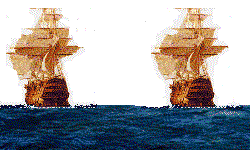Caribbean
Tales - Ships - Battle Tactics
Common Battle Tactics used by
the British and French Navies
The orthodox method of attack was in line ahead (hence
the term line of battle), both fleets running parallel to each other, and firing
broadsides at their opposing number. A few battles were fought like this, but
they seldom resulted in a decisive victory for either side, although the casualties
could be high.
Raking Fire
Attacking bow or stern of enemy

Raking fire was particularly devastating. Ships of this era were weakest at
the bow and the stern, if an attacking ship could manoeuvre to cross the enemy
in front or behind then they could fire directly down the length of the ship
as the guns came to bear.
The round shot bursting through the timbers resulted in a storm of splinters
through the deck, in many ways similar to the effect of modern shellfire.
In order to rake the enemy it was necessary to
sail through the enemy's line. This tactic exposed the lead ship of a column
to the broadside fire of the enemy, so this position was usually taken by a
1st rate or three decker. The Victory performed this role at Trafalgar,
taking the lead in the Weather column . The Royal Sovereign was at the
head of the Lee column. This was an unorthodox tactic and only the boldest and
most confident commanders utilised it .
With the introduction of longer range guns and
a change in ship construction later in the 19th century the tactic was reversed
and the commander aimed to 'cross the T', maximising his firepower at the expense
of his opponent.
Firing on the up roll

As a general rule the French felt that the best way to disable an enemy
ship was to destroy his means of manoeuvering. They therefore concentrated their
fire on the masts and rigging, launching their broadsides on the upward roll
of their ships. This fire policy often crippled the British ships, preventing
them from pressing home their attack, but was less deadly to the crew.
The British used the opposite tactic firing on the down roll into the enemy
hulls, causing a storm of flying splinters that killed and maimed the enemy
gun crews. These tactics were accentuated by the fact that the British tended
to choose the weather gauge and the French the lee, so the tendency was for
the French guns to be pointing high and the British low as their ships heeled
in the wind.
Although only a very general rule this contrast in tactics goes some way to
explaining the difference in casualty figures between the British and enemy
sailors. The British percentage of killed to total casualties was just over
25%, i.e. three wounded for every one killed. But for the enemy the percentage
was 55%, i.e. for every four wounded five were killed.
The speed with which the guns were loaded and fired by the Royal Navy gun crews
was also higher than the French and Spanish, also a factor in the higher casualty
figures for the enemy fleets.
The destruction of the enemy ship by gunfire was one
of three elements that could lead to death in battle; the other two were fire,
and the sea. No British ship was sunk or burnt in any of the great battles,
in fact only 8 ships of the line were burnt or blown up throughout the whole
war, 17 were wrecked and 3 foundered. The French suffered some major tragedies,
such as the Orient at the Battle of The Nile and the Indomitable
at Trafalgar, which lost 1250 men from a crew and troops numbering 1400.
To put the French losses in perspective we can look at
the casualty figures suffered by the British Navy in the American War of 1812.
Here the British ships came up against well trained and perhaps better motivated
seaman than any of the other navies they were engaged against. The Americans
trained with live ammunition more often than their British counterparts, the
British, spending long periods at sea, tended to reserve their supplies of powder
and shot for actual engagements. They also signed on for a set number of years,
as opposed to the British who were signed on indefinitely, and they were paid
as well or better than a skilled workman could earn ashore. They aimed their
guns directly into the enemy ships like the British, as well as at the masts.
When the USS Constitution with a crew of 456 defeated HMS Guerrierre,
crew 302, The Constitution suffered 14 casualties to the Guerrierre's
78. The American Frigates fired faster and more accurately than the British
thanks to training, the use of a new powder charge encased in lead not cloth,
(no need to swab out the gun), and gunsights, an innovation not utilised by
the British. Till this point the British captains had relied on getting their
ships close to the enemies, a tactic that meant rate of fire was more important
than accuracy at longer ranges.
The odds were in favour of the larger Amercan ships in the ship to ship engagements
that happened during the War of 1812, but the British were used to taking on
larger opponents and it must have been a shock to the Admiralty to start losing
such engagements so comprehensively.
Back to Ships

